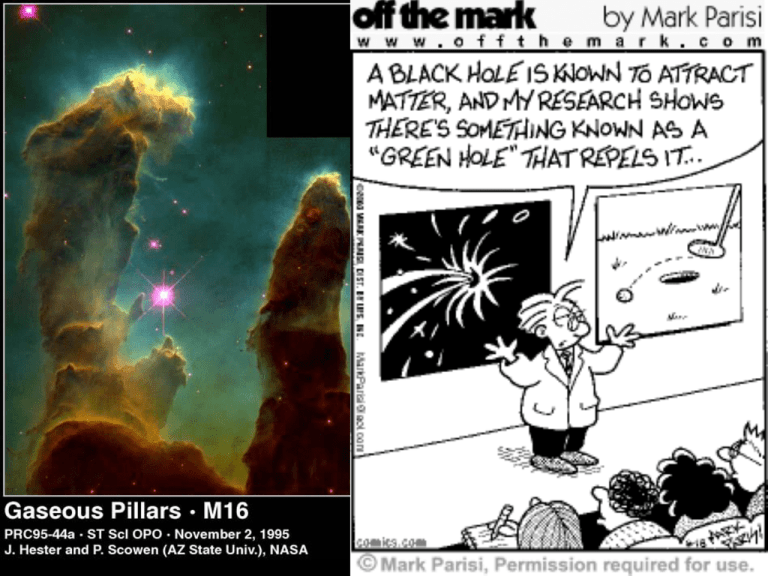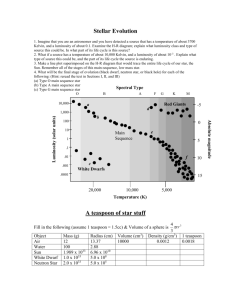Nucleosynthesis and Stellar Evolution
advertisement

BASIC IDEA Stars spend their lifetimes trying to stay in hydrostatic equilibrium and thermal equilibrium. When stars don't generate enough energy, they fall out of thermal and hydrostatic equilibrium and they evolve. The story of stellar evolution is simply the story of a star in its eternal struggle with gravity. • Now consider a “slab” of solar material. Aka a layer of the Sun. • The Suns interior is in hydrostatic equilibrium. • In general there is a balance between • Radiation pressure and • Gravitational pressure • If a star is in hydrostatic and thermal equilibrium, and it derives all of its energy from nuclear reactions, then its structure is completely and uniquely determined by its total mass and by the distribution of the various chemical elements throughout its interior. • In other words, the mass and composition, the properties a star is born with are just the properties which determine its structure. Figure from Foundations of Astronomy by M. Seeds CLICK HERE CNO CYCLE.mpg • Stars that have not quite balanced out yet are not on the Main Sequence • They are still very energetic and spew matter into space in an effort to stabilize (next slide) • May take as many as 10 Million years to stabilize H–R Diagram Supergiants Luminosity (Lsun) 106 104 102 Giants 1 10-2 10-4 40,000 White Dwarfs 20,000 10,000 5,000 Temperature (K) 2,500 Relative Star Sizes L M4 Main Sequence High Mass Luminosity (Lsun) 106 104 102 1 10-2 Low Mass 10-4 40,000 20,000 10,000 5,000 Temperature (K) 2,500 • During the main sequence phase there is a "feedback" process that regulates the energy production in the core and maintains the star's stability. The basic physical principles are: • The thermal radiation law, L ~ T4, determines the energy output, which fixes requirement for nuclear energy production. • The nuclear reaction rates are very strong functions of the central temperature; Reaction Rate ~ T4 for the P-P Chain. • The inward pull of gravity is balanced by the gas pressure which is determined by the Ideal Gas Law: PV=NRT Main Sequence Star Structure • At a certain point a star has burned enough hydrogen that the chemical structure changes. • The evolutionary path then depends on MASS Chandrasekhar, Subrahmanyan (1910-1995) An Indian-born American astrophysicist renowned for his theoretical work on compact celestial objects, notably white dwarfs and neutron stars. Evolution of Low Mass Stars (below the Chandrasekhar Limit) Climbing the Red Giant Branch Luminosity (Lsun) 106 104 Red Giant Branch 102 H-core exhaustion 1 10 -2 10 -4 40,000 20,000 10,000 5,000 Temperature (K) 2,500 Red Giant Star Structure Red Giant Star Inert He Core H Burning Shell Cool, Extended Envelope Horizontal Branch Helium Flash Luminosity (Lsun) 106 104 Horizontal Branch 102 Red Giant Branch H-core exhaustion 1 10 -2 10 -4 40,000 20,000 10,000 5,000 Temperature (K) 2,500 Horizontal Branch Star He Burning Core H Burning Shell Envelope The Asymptotic Giant Branch Asymptotic Giant Branch Luminosity (Lsun) 106 104 Horizontal Branch 102 Red Giant Branch H-core exhaustion 1 10 -2 10 -4 40,000 20,000 10,000 5,000 Temperature (K) 2,500 Asymptotic Giant Branch Star H Burning Shell He Burning Shell Inert C-O Core Cool, Extended Envelope Planetary Nebula Phase Bare Core Envelope Ejection Luminosity (Lsun) 106 104 102 1 10 -2 White Dwarf 10 -4 40,000 20,000 10,000 5,000 Temperature (K) 2,500 Evolution of High Mass Stars (above the Chandrasekhar Limit) Red Supergiant Branch Luminosity (Lsun) 106 Red Supergiant 104 102 1 10 -2 10 -4 40,000 20,000 10,000 5,000 Temperature (K) 2,500 Red Supergiant Star Inert He Core H Burning Shell Cool, Extended Envelope Not to Scale Blue Supergiant Blue Supergiant Helium Flash Luminosity (Lsun) 106 104 102 1 10 -2 10 -4 40,000 20,000 10,000 5,000 Temperature (K) 2,500 End of Helium Burning Luminosity (Lsun) 106 104 102 1 10 -2 10 -4 40,000 20,000 10,000 5,000 Temperature (K) 2,500 End of Carbon Burning Phase H Burning Shell He Burning Shell Inert O-Ne-Mg Core C Burning Shell Red Supergiant Envelope End of the Silicon Burning Phase H Burning Shell He Burning Shell Core Radius: ~1 Rearth C Burning Shell Ne Burning Shell Inert Fe-Ni Core O Burning Shell Si Burning Shell Envelope Radius: ~ 5 AU Supernova Remnant and Neutron Star Close up Image of Jet Near A Black Hole A Black Hole? Black Hole • A pulsar is a neutron star which emits beams of radiation that sweep through the earth's line of sight. Like a black hole, it is an endpoint to stellar evolution. • The "pulses" of high-energy radiation we see from a pulsar are due to a misalignment of the neutron star's rotation axis and its magnetic axis. • Pulsars pulse because the rotation of the neutron star causes the radiation generated within the magnetic field to sweep in and out of our line of sight with a regular period. http://science.nasa.gov/NEWHOME/help/tutorials/pulsar.htm Black hole pics to use K. Schwarzschild (1873-1916) • Develop the mathematics for determining the Schwarzschild radius of Black Holes • S’s already know about escape velocity from planets. Relate this to black holes for light to determine masses of Black Holes







